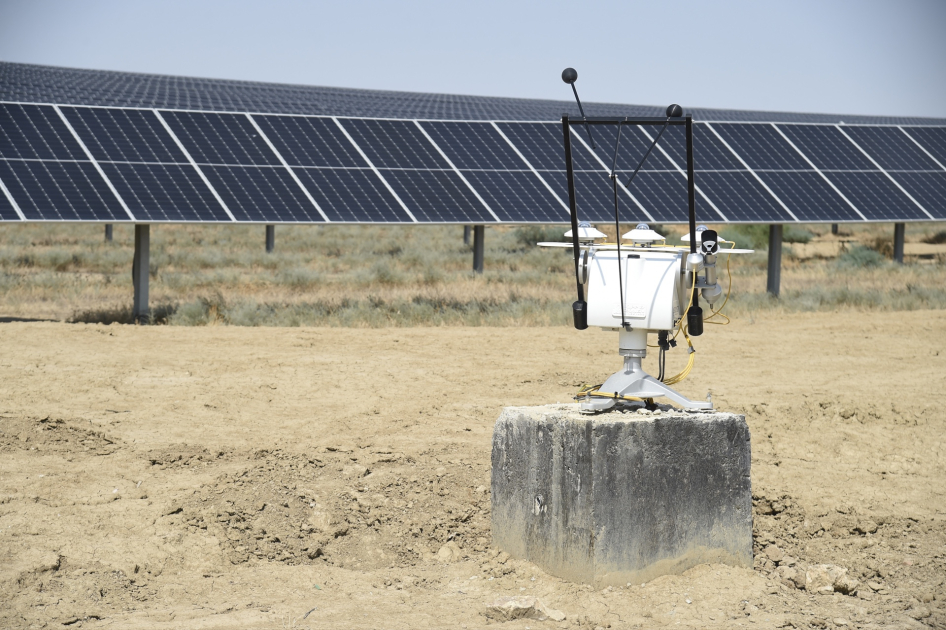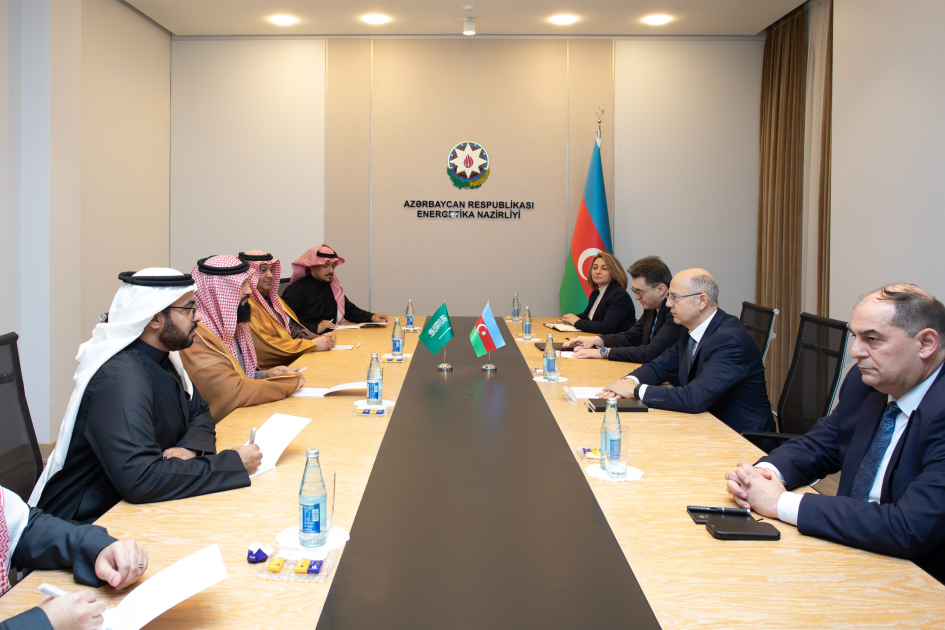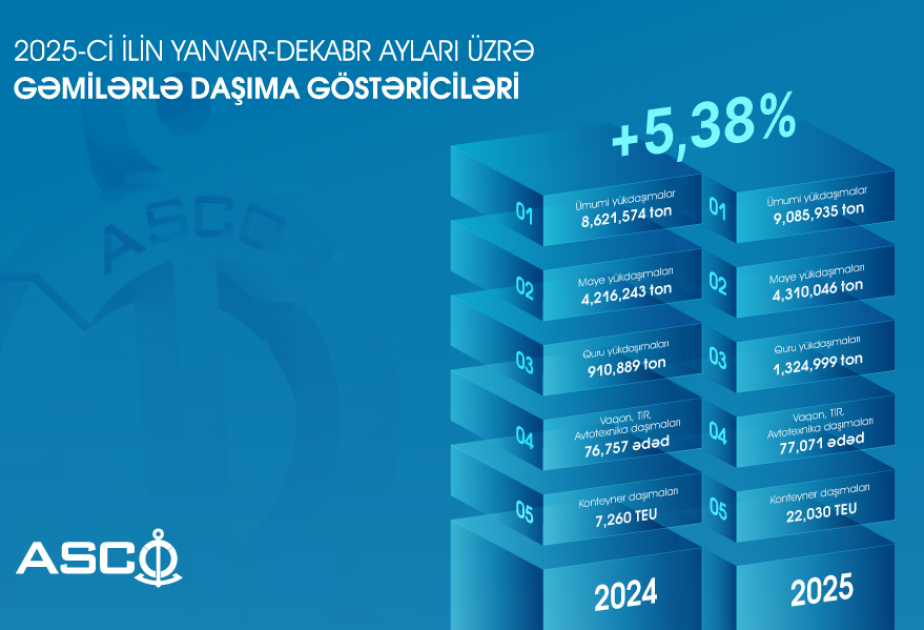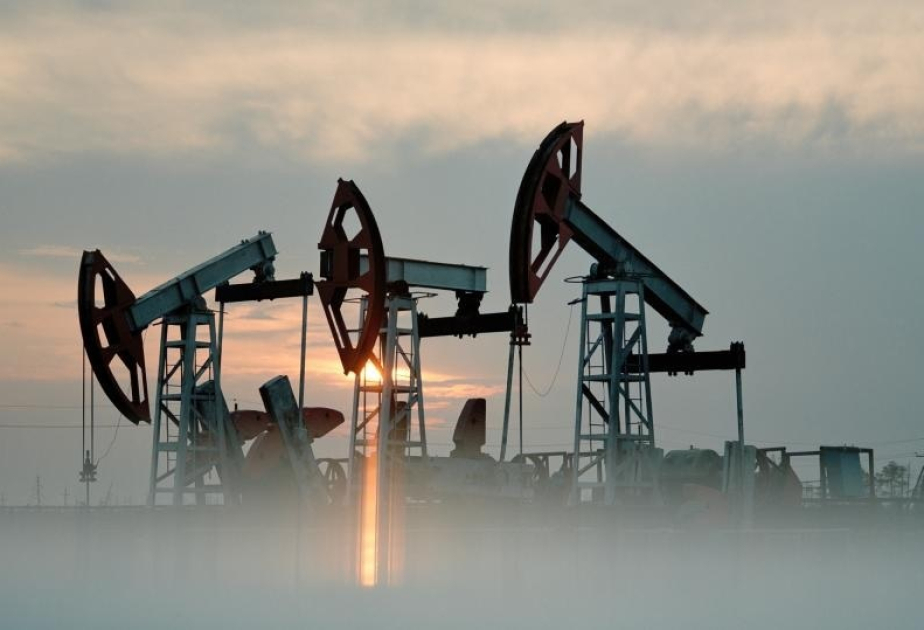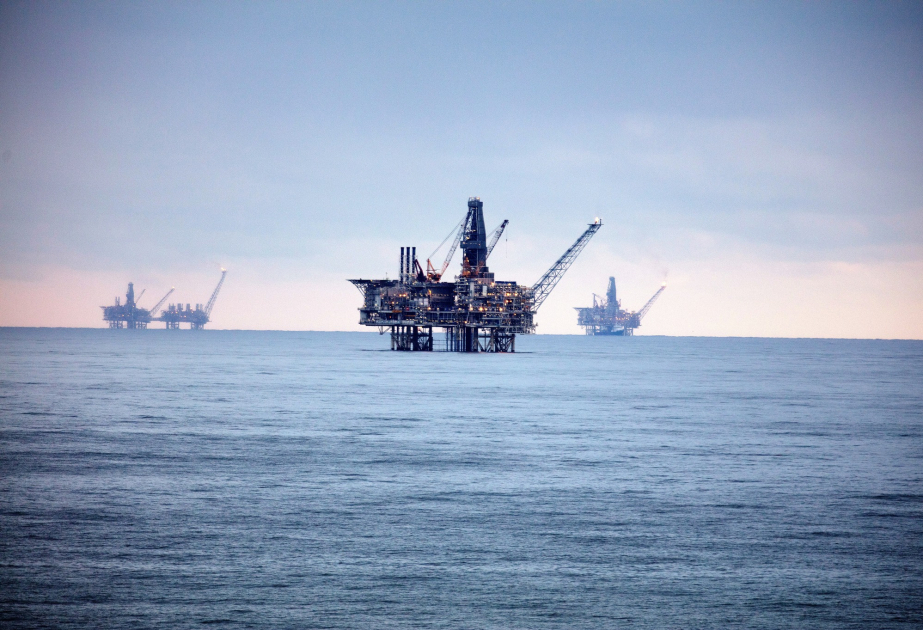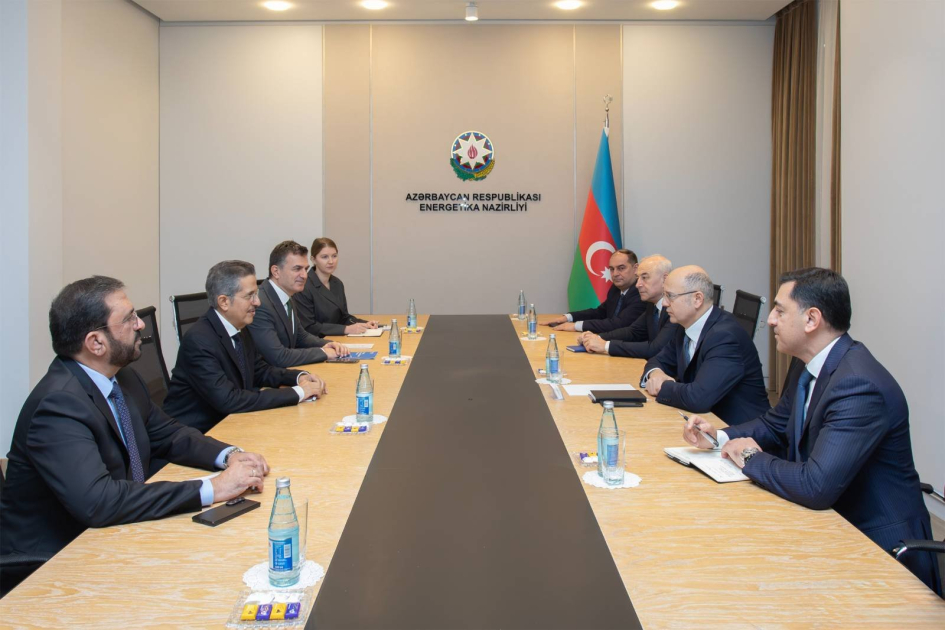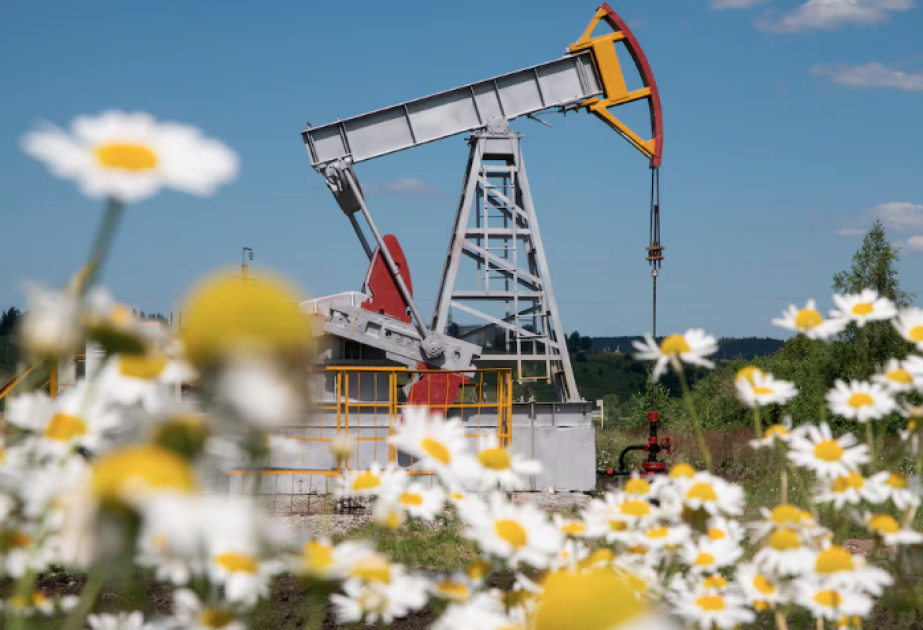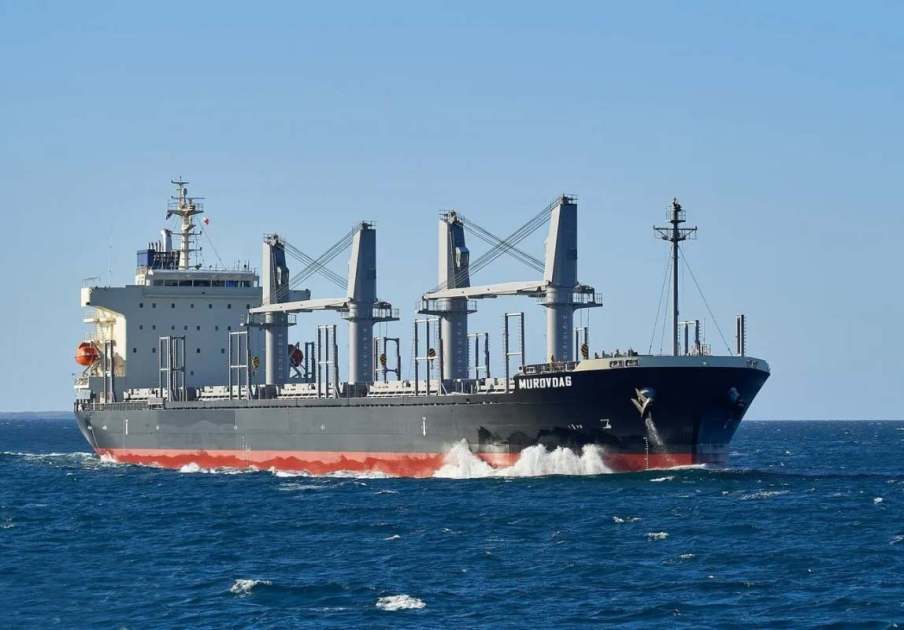ECONOMY
REPORT from Garadagh Solar Power Plant, the “sunflower” of Azerbaijan's green energy policy
14.09.2024 [16:53]
A+ A-
1 / 10
Garadagh, September 14, AZERTAC
It isn’t just nature that revives with the first rays of the sun. In Garadagh district of Baku, the most tireless workers of these places, the solar panels, are scattered over a vast expanse. The Garadagh Solar Power Plant located here is one of the largest in the Caspian region and the CIS. Most importantly, the Garadagh Solar Power Plant was built with direct foreign investment and is the country’s first industrial-scale solar power plant. We should note that in 2022, “Masdar Azerbaijan Energy” LLC was registered by the state of Azerbaijan and attracted a total of 114.2 million dollars to capitalize the solar power plant project. The list of lenders includes the European Bank for Reconstruction and Development (EBRD), the Asian Development Bank (ADB), the Japan International Cooperation Agency (JICA) and the Abu Dhabi Fund for Development (ADFD). But let's take a look at the history of this project.
The Garadagh Solar Power Plant project was developed and implemented by “Masdar”, a company of the United Arab Emirates (UAE). Then construction was started and in March 2022, President Ilham Aliyev attended the groundbreaking ceremony of the solar power plant. Construction work was completed in a record time, in a matter of 19 months, and the station was put into operation. The prevention of 265,000 tons of carbon dioxide emission into the atmosphere thanks to the operation of the Garadagh Solar Power Plant is a factor worth emphasizing. As a result, the project will contribute to solving one of the main UN Sustainable Development Goals (SDGs) – the decarbonization of energy and industry, which our country is striving for in accordance with the Paris Climate Agreement.
Today we will describe the operating principle of these devices and try to explain to our readers their benefits as plainly as possible. So one day in August, we “armed” ourselves with a camera and stepped into the barren land of solar panels to the accompaniment of the scorching sun and a cool breeze.
Familiarization with the Garadagh Solar Power Plant
The location of the power plant was not chosen by chance – the number of sunny days on the Absheron plain reach the maximum compared to the national average. As a result, more than 570,000 solar panels installed here will work at their maximum capacity and increase the profitability of production.
Now we need to take a closer look at this device. We are equipped with special protective shoes because, according to the local personnel, there may be scorpions and poisonous snakes lurking nearby. Solar panels are a combination of individual elements made of semiconductor materials that allow them to convert the solar energy they receive into electricity.
Employees of the solar power plant explain to us the further operating principle of the device: first the rays hit the silicon plates. Then electrons are released and start moving along the conductors. The inverter then converts the direct current into alternating current, which allows it to power household appliances. At night and on cloudy days, the solar power plant uses batteries to store energy. The batteries are charged during the day and then used to power the inverter at night or in cloudy weather.
This device is quite interesting. For example, such a panel can be used as an alternative for charging a mobile phone or laptop. The main thing is that the panels are arranged in a row in a precise sequence, because a connection scheme for all elements of the power plant must be designed and a place for installing the solar panels must be chosen correctly.
The solar cell, in turn, consists of several panels mounted on a frame. This is a cable that connects the panels to the inverter. According to “Masdar” employees, the control system is located in the office and has a screen that displays information about the system's operation.
The workers then show us a robotic device designed to clean the solar panels. This system is based on the technology of creating an air flow, applying antistatic microfiber cloth to the surface of the panels, and most importantly, without using water. The device moves on small wheels along a row of solar panels.
At this point, we seem to hear a slight hissing sound. This is the sound of our panels slowly changing direction along with the sun as the sun alternates the direction of its rays.
If batteries require light, then how do solar panels work in cloudy weather or even rain?
According to “Masdar” employees, rain does not affect the operation of solar cells and the production of electricity. Cloudy weather accompanied by rain may create a more significant effect. It is clouds that become a serious obstacle for solar panels, significantly reducing efficiency.
But how can wind improve the efficiency of solar panels?
Wind gusts reduce the surface temperature of solar panels, increasing their power and efficiency in converting solar energy into electricity. The commissioning of the Garadagh Solar Power Plant opens a new page in the history of Azerbaijan's electricity generation. In the last few years, Baku has been taking important steps to speed up the energy transition. To date, there is a large portfolio of projects in the field of renewable energy, and their implementation will give a strong impetus to the development of this industry. In particular, three elements – wind, solar and water – will soon begin to define the map of Azerbaijan's energy sector. If we add to this the interest and attention the country's leadership is paying to the development of renewable energy sources, Azerbaijan will, no doubt, become one of the world's leading countries in the development of the energy industry in the coming years. In this sense, the groundbreaking of the giant solar power plant in Garadagh is the first large-scale step towards this goal.
We have decided to talk to Murad Sadikhov, the head of the Azerbaijan representative office of “Masdar”, to obtain more detailed information about the Garadagh Solar Power Plant.
- Mr. Sadikhov, what assistance will “Masdar” and the UAE delegation provide to the Government of Azerbaijan for the successful hosting of COP29 this year? And how would you assess the possibility of concluding additional agreements between “Masdar” and Azerbaijan within the COP29 conference?
- As you may know, COP28 was held in the United Arab Emirates. The President of COP28 is Sultan Al Jabir, who also happens to be the Chairman of the Board of Directors of “Masdar”. For the first time in history, a tripartite mechanism has been established within COP29 to coordinate efforts on climate change, i.e. the former president, the current president and the future president.
“Masdar” is actively involved in this, providing important assistance to Baku. Currently, we are working in several directions with the Government of Azerbaijan. The Garadagh Solar Power Plant was inaugurated in October last year. As part of the opening of the power plant, we signed three investment contracts for a total capacity of 1 gigawatt. These include a 445 MW Bilasuvar Solar Power Plant, a 315 MW Neftchala Solar Power Plant and a 240 MW Absheron-Garadagh Wind Plant. On June 4 this year, additional contracts were signed on the sale of energy, connection to networks and land lease. Within the framework of these operations, very extensive preparations are currently underway to ensure financing of projects and start construction work. We are doing our best to implement the necessary work as soon as possible and hope to sign contracts within the framework of these obligations. In terms of additional projects, we signed two contracts for a total capacity of 10 gigawatts in 2022, of which 4 gigawatts are onshore and 6 gigawatts are offshore. Offshore energy is also related to the production of “green hydrogen”.
- What stage is the implementation of the hydrogen production project at now?
- As part of this project, we are currently completing work on the feasibility study for the production of “green hydrogen” and its derivatives in Azerbaijan, i.e. how and in what form we can export “green hydrogen”, how we can use it in the production of synthetic gas, methane, fertilizer, ammonia and whether it can be used in the production of other materials that are currently in demand in foreign markets. Within the framework of this feasibility study, we are calculating the capacity of potential markets that can justify the production of “green hydrogen” in Azerbaijan.
- How would you evaluate the Garadagh Solar Power Plant project implemented between our countries?
- The Garadagh Solar Power Plant is the largest and most advanced plant in the Caspian region in terms of equipment. This plant makes a great contribution to the structure of energy production in Azerbaijan. It is also a good platform for expanding cooperation. Thanks to the station, we have signed new contracts and plan to expand our cooperation even more. Our main partner is “AzerEnergy”, which buys energy from us. We work as a team, which means that the experience gained from the cooperation between “AzerEnergy” and “Masdar” will be applied to other projects accordingly. This project allows us the opportunity to save approximately 120 million cubic meters of gas. It also reduces carbon dioxide emissions by 200,000 tons per year. About 550 million kilowatt-hours of energy produced here is enough to supply 110,000 homes with electricity. This is a pretty big impact. The volume of investments is at least 1 billion dollars. Gas saving accounts for more than 500 million cubic meters. To put it into perspective, it is almost like a gas field operating at fairly large volumes and reducing CO2 emissions by about a million tons per year. Without mentioning the sheer economic impact of data processing, the impact is truly huge. The importance of this station also rests in the fact that it creates “green certificates” that Azerbaijan can then use to stimulate its exports to the European Union and other countries.
- At what stage are the projects of creating batteries in Azerbaijan?
- We are currently engaged in consultations with the Government of Azerbaijan and the Ministry of Energy. We have expressed our interest and are ready to conclude an appropriate agreement with the Government of Azerbaijan. Preparations are now underway. The Ministry of Energy has announced a tender for the preparation of technical specifications of batteries. I do hope that we will be ready to participate before the parameters of storage systems to be used by Azerbaijan are determined. “Masdar” has considerable experience in storage systems. Today, we are implementing projects in Uzbekistan. Without storage systems, the future development of renewable energy in Azerbaijan will be problematic. In 2022, we signed a 10 gigawatt contract with the Government of Azerbaijan, and one of our commitments and proposals to the Government of Azerbaijan was to set up a joint working group and conduct research on the integration of renewable energy sources into the grid. We have attracted leading specialists, companies from the USA, while Azerbaijan has attracted consultants from Turkiye. And as a result, a static and dynamic network model was developed for the first time in the history of Azerbaijan. Thanks to this model, the main parameters, as well as areas that need to be modernized to ensure the integration of green energy, have been identified. One of the proposals includes the creation of storage systems with a capacity of at least 250 megawatt-hours in the territory of Azerbaijan in order to balance renewable sources. We will be happy to implement this project and achieve successful results.
- How can “Masdar” contribute to bolstering the potential of offshore wind energy in the Caspian Sea?
- We have signed a 6 gigawatt contract for offshore wind energy. Within the framework of this agreement, feasibility studies for the use of offshore wind energy are being developed and areas have been identified. We intend to install the relevant equipment at sea, conduct research and more precisely determine the parameters of turbines, as well as their location. We do hope that the Cabinet of Ministers and the Ministry of Energy complete the review of our application in the near future.
- When are the solar power plants in Neftchala and Bilasuvar to be commissioned? What benefits will “Masdar” and Azerbaijan get from these projects?
- There are plans to start construction in Bilasuvar by the end of this year. High-voltage power lines will connect each section to the “AzerEnergy” network. At the same time, “Navai” substations are under construction built. In other words, complete modernization of networks is underway. We are told that work will be completed in the first quarter of 2026, which means that we will be able to join on April 1, 2026. Accordingly, these two stations will start transmitting power from April 1. Annual electricity production in Bilasuvar is planned to be at least 900 million kilowatt-hours and in Neftchala to 650 million kilowatt-hours. These projects are being implemented without state guarantees. The minimum investment volume for these two projects alone will be approximately 700 million dollars, and gas savings from the operation of these two projects will be approximately 330-340 million cubic meters.
- Why were these specific areas chosen?
- Together with the Ministry of Energy, we conducted a research of facilities in various directions for about a year and a half. Several parameters were taken into account. One of the parameters was that the land must be unsuitable for agricultural activities. The second point, of course, was solar activity. This zone should have appropriate solar activity and large enough areas. Because the 230-megawatt Garadagh project covers an area of 550 hectares. For example, the territory of Bilasuvar is 1,454 hectares and of Neftchala is 973 hectares. These are quite large plots of land that are unusable. This is why we chose these areas in consultation with the Government of Azerbaijan and the Cabinet of Ministers.
- What projects does “Masdar” intend to implement in Central Asia and the Caucasus in the near future?
- In Azerbaijan, as I told you, our project portfolio consists of 10 gigawatts. We are currently implementing a 1 gigawatt project, and we hope to increase it in the near future as soon as the appropriate network capacity is created and the opportunities to export “green hydrogen” are identified. We will begin to increase our capacity accordingly. These are 1.5 gigawatt solar power plants. The 500 MW wind power plant is being expanded. We also have a 100 MW solar power plant in Georgia, but these are still at the stage of negotiations.
- How can “Masdar” help Azerbaijan become a leader in the global transition to sustainable energy?
- One of the projects is energy export from Nakhchivan to Turkiye. In all these projects, we, as green energy producers, coordinate our efforts with the state. For example, we have signed an agreement on the construction of solar power plants with a total capacity of 500 megawatts in Nakhchivan. “ACWA Power”, “Masdar” and SOCAR are participating in this project. We are ready to invest in the production of this energy as soon as Azerbaijan and Turkiye conclude an appropriate agreement on laying the export cable. We have offshore energy. It is one of the most promising export markets, an opportunity to export energy to the European Union. Thus, all the projects implemented by “Masdar” in the territory of Azerbaijan are promising not only for Azerbaijan, but also for the entire region, because they envisage exports to European countries. Today, Azerbaijan is one of the important countries chosen by the United Arab Emirates Government for investment. We have chosen Baku as a strategic destination for investment, and the investment climate and macroeconomic indicators of Azerbaijan are very attractive for us.
- What are the disadvantages of green energy from your point of view?
- I am sure that green energy always has an advantage. Of course, there are technical limitations. Green energy is variable, which means it is dependent on the weather. It cannot provide stable power and network load. Therefore, various methods are used to enhance the use of renewable energy in the grid. One of them is the use of energy storage systems, i.e. storage systems that play the stabilizing role and ensure an uninterrupted supply of energy. Modern management methods of network management based on artificial intelligence are applied in the United Arab Emirates. Network management occurs automatically thanks to the rapid response of artificial intelligence, which allows balancing certain capacities without using memory systems. So all these modern methods are currently being studied, and I do hope that we will see all of them in Azerbaijan in the near future.
- When do you think Azerbaijan will be able to completely switch to green energy?
- You know, first of all, everything depends on the strategy Azerbaijan will be implementing. Baku is committed to maximizing the use of green energy, and this has various aspects. One of the aspects is the improvement of the ecological situation in Azerbaijan. Currently, the Government is importing electric cars and electric buses. All this will play a major role in protecting the environment. The transition to green energy will expand Azerbaijan's export opportunities, reduce its dependence on conventional hydrocarbons and improve the ecological system in the country.


